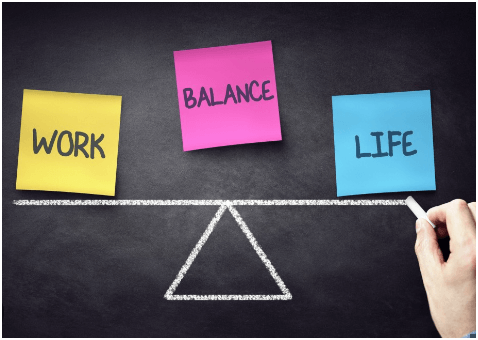work-life balance has become a pressing concern for many professionals. With the growing integration of technology into everyday life, boundaries between personal time and professional responsibilities have become increasingly blurred.
Many people find themselves constantly connected to their work through smartphones, laptops, and other digital devices, making it difficult to unplug and create space for personal well-being. The constant influx of emails, notifications, and messages creates an environment where work seems to follow individuals everywhere, even into their homes, significantly impacting their ability to unwind and enjoy their personal lives. However, by setting clear boundaries, managing screen time, and cultivating a mindful approach to balancing career and personal life, it is possible to reclaim one’s time and establish a healthier relationship with work.
The first step in regaining control over one’s time is the creation of clear boundaries between work and personal life. With the increasing trend of remote and hybrid work models, it has become more challenging to distinguish when the workday begins and ends. To address this, individuals should start by defining set work hours and adhering to them. It is crucial to communicate these boundaries to colleagues, supervisors, and clients to manage expectations. For example, informing your team that you are available from 9 AM to 5 PM can reduce the likelihood of receiving work-related requests outside of those hours. This approach not only creates structure but also helps you mentally switch off from work when the day is over.
In addition to setting time-based boundaries, physical separation of work and personal spaces can be a valuable strategy for promoting work-life balance. For those who work from home, this might mean designating a specific room or area as a home office. When this space is used solely for work, it becomes easier to associate it with professional tasks and disconnect from those tasks when you leave the space. Similarly, avoiding work-related activities, such as checking emails or taking calls, in personal spaces like the bedroom or living room can reinforce the boundary between work and relaxation. This clear distinction helps create a psychological barrier, enabling individuals to leave their work behind when the day ends.
Managing screen time is another crucial aspect of balancing work and personal life in the digital era. Many people find themselves spending excessive amounts of time on screens, whether for work, leisure, or social interactions. While technology has undoubtedly brought many conveniences, overuse can contribute to stress, fatigue, and burnout. A key strategy for managing screen time is to track how much time is spent on different devices and activities. Many smartphones offer built-in tools that allow users to monitor their screen time, providing insights into how much time is dedicated to specific apps or tasks. Once individuals have a clear picture of their screen habits, they can begin to set limits.
Reducing unnecessary screen time can be achieved by setting designated periods for digital activities. For example, checking work emails can be limited to certain times of the day, rather than constantly throughout the day. Similarly, limiting social media use or entertainment consumption to specific windows of time can prevent these activities from encroaching on personal time. Additionally, implementing “no-screen” hours, such as the first hour after waking up or the last hour before bed, can help create a more mindful approach to the day, promoting relaxation and focus.
Learning to say no is another essential skill for managing time and maintaining work-life balance. In the fast-paced digital world, it is easy to fall into the trap of constant availability, responding to every email, message, or request as soon as it arrives. While it may seem efficient in the short term, this behavior can lead to burnout and a loss of personal time. It’s important to assess which tasks are urgent and require immediate attention and which can be postponed or delegated. By prioritizing what truly needs to be addressed, individuals can free up time to focus on tasks that align with their long-term goals or personal needs. Additionally, setting clear boundaries with colleagues regarding when you are available for work-related communication can reduce the pressure to be constantly connected.
Taking breaks throughout the workday is another vital element of maintaining balance. Research has shown that regular breaks, even short ones, can improve productivity and reduce stress levels. These breaks can be as simple as taking a walk, stretching, or stepping away from the computer for a few minutes. It’s important to schedule these breaks intentionally, ensuring that you take time to recharge both physically and mentally. Longer breaks, such as vacations or extended time off, should also be prioritized, allowing individuals to fully disconnect from work and return with renewed energy and focus.
Mindfulness practices, such as meditation, can also play a significant role in managing the stresses of the digital age. With constant distractions and the pressure to multitask, many people find themselves feeling overwhelmed by their responsibilities. Mindfulness encourages individuals to stay present and focused on one task at a time, which can help reduce anxiety and improve overall productivity. Setting aside even a few minutes each day for mindfulness exercises, such as deep breathing or guided meditation, can make a noticeable difference in how individuals approach their work and personal life.
Work-life balance is not just about limiting work- life hours or reducing screen time; it’s also about actively creating time for activities that bring joy and fulfillment outside of work. Pursuing hobbies, spending time with loved ones, and engaging in physical activities are all important for maintaining overall well-being. These activities provide an opportunity to recharge and bring balance to the demands of the workday. Scheduling time for personal interests and social interactions is just as important as scheduling work tasks, ensuring that both aspects of life are given equal priority.
For many, achieving work-life balance in the digital age may require a shift in mindset. Rather than viewing balance as a rigid separation between work and life, it can be helpful to approach it as a dynamic, ongoing process that requires regular reassessment. As professional and personal demands change, so too should the strategies for managing them. By remaining flexible and adapting to new circumstances, individuals can create a sustainable balance that works for them.
In conclusion, achieving work-life balance in the digital age Work-Life is possible with intentional efforts to set boundaries, manage screen time, and prioritize personal well-being. It requires a combination of clear communication, mindful technology use, and a commitment to personal interests outside of work. While the digital world presents unique challenges, it also offers opportunities for individuals to take control of their time and create a healthier, more fulfilling lifestyle. By implementing these strategies and continuously reflecting on what works best, individuals can reclaim their time and thrive in both their professional and personal lives.
Stay Connected: ”Your Source for the Latest News Updates”





